Apache的ProxyPass指令详解
Apache配置正向代理与反向代理
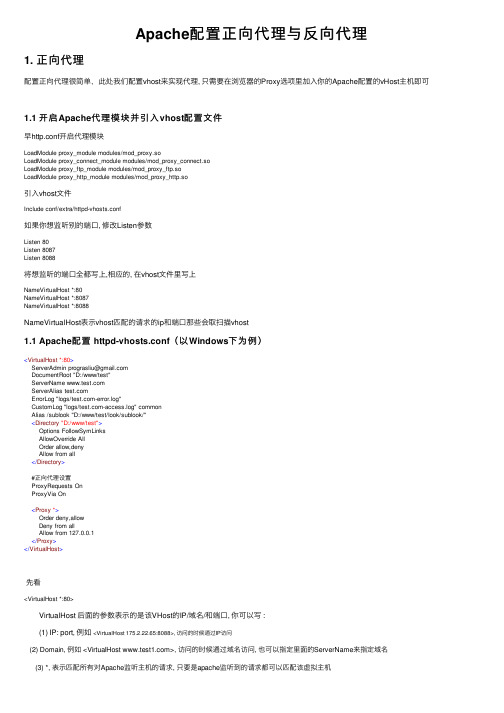
Apache配置正向代理与反向代理1. 正向代理配置正向代理很简单,此处我们配置vhost来实现代理, 只需要在浏览器的Proxy选项⾥加⼊你的Apache配置的vHost主机即可1.1 开启Apache代理模块并引⼊vhost配置⽂件早http.conf开启代理模块LoadModule proxy_module modules/mod_proxy.soLoadModule proxy_connect_module modules/mod_proxy_connect.soLoadModule proxy_ftp_module modules/mod_proxy_ftp.soLoadModule proxy_http_module modules/mod_proxy_http.so引⼊vhost⽂件Include conf/extra/httpd-vhosts.conf如果你想监听别的端⼝, 修改Listen参数Listen 80Listen 8087Listen 8088将想监听的端⼝全都写上,相应的, 在vhost⽂件⾥写上NameVirtualHost *:80NameVirtualHost *:8087NameVirtualHost *:8088NameVirtualHost表⽰vhost匹配的请求的ip和端⼝那些会取扫描vhost1.1 Apache配置 httpd-vhosts.conf(以Windows下为例)<VirtualHost *:80>ServerAdmin prograsliu@DocumentRoot "D:/www/test"ServerName ServerAlias ErrorLog "logs/-error.log"CustomLog "logs/-access.log" commonAlias /sublook "D:/www/test/look/sublook/"<Directory "D:/www/test">Options FollowSymLinksAllowOverride AllOrder allow,denyAllow from all</Directory>#正向代理设置ProxyRequests OnProxyVia On<Proxy *>Order deny,allowDeny from allAllow from 127.0.0.1</Proxy></VirtualHost>先看<VirtualHost *:80> VirtualHost 后⾯的参数表⽰的是该VHost的IP/域名/和端⼝, 你可以写 : (1) IP: port, 例如<VirtualHost 175.2.22.65:8088>, 访问的时候通过IP访问(2) Domain, 例如 <VirtualHost >, 访问的时候通过域名访问, 也可以指定⾥⾯的ServerName来指定域名(3) *, 表⽰匹配所有对Apache监听主机的请求, 只要是apache监听到的请求都可以匹配该虚拟主机此处表⽰的就是监听所有80端⼝的请求, 但是由于ServerName⾥写了, 所以这个vhost匹配的是:80, 现在看正向代理设置那⼀段ProxyRequests On:开启Apache正向代理ProxyVia On:控制位于代理服务器链中的代理请求的流向 引⽤Apache2.2官⽅⽂档中对ProxyVia的解释如下:a. 如果设置为默认值Off,将不会采取特殊的处理。
Apache ReWriteRule参数

RewriteRule /foo/(.*) /bar?arg=P1\%3d$1 [R,NE]
* 'qsappend|QSA' (追加请求串 query string append)
此标记强制重写引擎在已有的替换串中追加一个请求串,而不是简单的替换。 如果需要通过重写规则在请求串中增加信息,就可以使用这个标记。
* 'noescape|NE' (在输出中不对URI作转义 no URI escaping)
注意: 在使用这个标记时,必须确保该替换字段是一个有效的URL! 否则,它会指向一个无效的位置! 并且要记住,此标记本身只是对URL加上 http://thishost[:thisport]/的前缀,重写操作仍然会继续。 通常,你会希望停止重写操作而立即重定向,则还需要使用'L'标记.
可以使'/foo/zed'转向到一个安全的请求'/bar?arg=P1=zed'.
* 'passthrough|PT' (移交给下一个处理器 pass through)
此标记强制重写引擎将内部结构request_rec中的uri字段设置为 filename字段的值,它只是一个小修改,使之能对来自其他URI到文件名翻译器的 Alias,ScriptAlias, Redirect 等指令的输出进行后续处理。举一个能说明其含义的例子: 如果要通过mod_rewrite的重写引擎重写/abc为/def, 然后通过mod_alias使/def转变为/ghi,可以这样:
Apache的ProxyPass指令详解

描述:将远程服务器映射到本地服务器的URL空间语法:ProxyPass [路径] !|url [键=值键=值...]] [nocanon]上下文:server config, virtual host, directory状态:扩展模块:mod_proxy该指令可以将远程服务器映射到本地服务器的URL空间;本地的服务器并不是扮演传统意义上的代理服务器的角色,而是表现为远程服务器的一个镜像。
此本地服务器常被成为反向代理(reversed proxy)或者是网关(gateway)。
路径是指本地虚拟路径的名字;url指远程服务器的一个部分URL,不能包含查询字符串。
注意:在使用ProxyPass指令的时候,ProxyRequests指令通常都应该是关闭的。
假设本地服务器的地址是/ ,那么ProxyPass /mirror/foo/ /将会把对/mirror/foo/bar的本地请求内部转换成到/bar的代理请求。
其中,!指令当你不想对某个子目录进行反向代理的时候就有用了,例如:ProxyPass /mirror/foo/i !ProxyPass /mirror/foo 将会把所有的/mirror/foo请求重定向到除了对/mirror/foo/i的请求。
注意:顺序很重要:排除的指令必须在一般的ProxyPass指令之前。
和Apache 2.1一样,具备了使用到后端服务器的线程池的能力。
使用“键=值”的参数便可调节线程池的分配。
硬性最大值(Hard Maximum)的默认值为当前MPM中每个进程的线程数量。
在Prefork MPM中,该值总是为1,在Worker MPM中,该值受ThreadsPerChild控制。
设置min可以决定有多少到后端服务器的链接始终打开。
根据需要最多创建数量为柔性最大值(Soft Maximum),也就是smax的链接。
任何超出smax数量的链接都会指定一个生存时间也就是ttl。
Nginx服务器的反向代理proxy_pass配置方法讲解
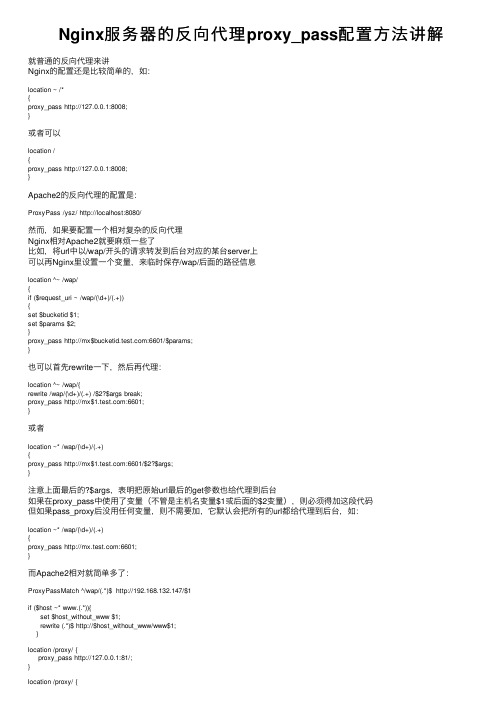
Nginx服务器的反向代理proxy_pass配置⽅法讲解就普通的反向代理来讲Nginx的配置还是⽐较简单的,如:location ~ /*{proxy_pass http://127.0.0.1:8008;}或者可以location /{proxy_pass http://127.0.0.1:8008;}Apache2的反向代理的配置是:ProxyPass /ysz/ http://localhost:8080/然⽽,如果要配置⼀个相对复杂的反向代理Nginx相对Apache2就要⿇烦⼀些了⽐如,将url中以/wap/开头的请求转发到后台对应的某台server上可以再Nginx⾥设置⼀个变量,来临时保存/wap/后⾯的路径信息location ^~ /wap/{if ($request_uri ~ /wap/(\d+)/(.+)){set $bucketid $1;set $params $2;}proxy_pass http://mx$:6601/$params;}也可以⾸先rewrite⼀下,然后再代理:location ^~ /wap/{rewrite /wap/(\d+)/(.+) /$2?$args break;proxy_pass http://mx$:6601;}或者location ~* /wap/(\d+)/(.+){proxy_pass http://mx$:6601/$2?$args;}注意上⾯最后的?$args,表明把原始url最后的get参数也给代理到后台如果在proxy_pass中使⽤了变量(不管是主机名变量$1或后⾯的$2变量),则必须得加这段代码但如果pass_proxy后没⽤任何变量,则不需要加,它默认会把所有的url都给代理到后台,如:location ~* /wap/(\d+)/(.+){proxy_pass :6601;}⽽Apache2相对就简单多了:ProxyPassMatch ^/wap/(.*)$ http://192.168.132.147/$1if ($host ~* www.(.*)){set $host_without_www $1;rewrite (.*)$ http://$host_without_www/www$1;}location /proxy/ {proxy_pass http://127.0.0.1:81/;}location /proxy/ {proxy_pass http://127.0.0.1:81;}location /proxy/ {proxy_pass http://127.0.0.1:81/ftlynx/; }location /proxy/ {proxy_pass http://127.0.0.1:81/ftlynx; }。
nginxlocation、Rewrite、proxy_pass配置
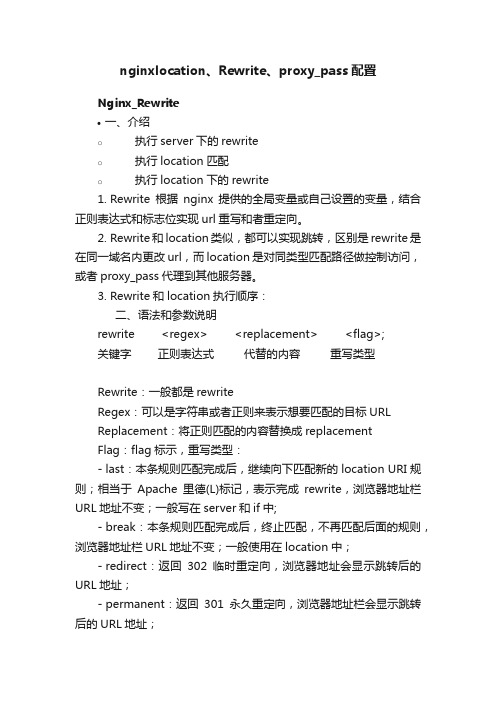
nginxlocation、Rewrite、proxy_pass配置Nginx_Rewrite•一、介绍o执行server下的rewriteo执行location匹配o执行location下的rewrite1.Rewrite根据nginx提供的全局变量或自己设置的变量,结合正则表达式和标志位实现url重写和者重定向。
2.Rewrite和location类似,都可以实现跳转,区别是rewrite是在同一域名内更改url,而location是对同类型匹配路径做控制访问,或者proxy_pass代理到其他服务器。
3.Rewrite和location执行顺序:二、语法和参数说明rewrite <regex> <replacement> <flag>;关键字正则表达式代替的内容重写类型Rewrite:一般都是rewriteRegex:可以是字符串或者正则来表示想要匹配的目标URLReplacement:将正则匹配的内容替换成replacementFlag:flag标示,重写类型:- last:本条规则匹配完成后,继续向下匹配新的location URI规则;相当于Apache里德(L)标记,表示完成rewrite,浏览器地址栏URL地址不变;一般写在server和if中;- break:本条规则匹配完成后,终止匹配,不再匹配后面的规则,浏览器地址栏URL地址不变;一般使用在location中;- redirect:返回302临时重定向,浏览器地址会显示跳转后的URL地址;- permanent:返回301永久重定向,浏览器地址栏会显示跳转后的URL地址;server {# 访问 /last.html 的时候,页面内容重写到 /index.html 中,并继续后面的匹配,浏览器地址栏URL地址不变rewrite /last.html /index.html last;# 访问 /break.html 的时候,页面内容重写到 /index.html 中,并停止后续的匹配,浏览器地址栏URL地址不变;rewrite /break.html /index.html break;# 访问 /redirect.html 的时候,页面直接302定向到 /index.html中,浏览器地址URL跳为index.htmlrewrite /redirect.html /index.html redirect;# 访问 /permanent.html 的时候,页面直接301定向到 /index.html中,浏览器地址URL跳为index.htmlrewrite /permanent.html /index.html permanent;# 把 /html/*.html => /post/*.html ,301定向rewrite ^/html/(.+?).html$ /post/$1.html permanent;# 把 /search/key => /search.html?keyword=keyrewrite ^/search\/([^\/]+?)(\/|$) /search.html?keyword=$1 permanent;# 把当前域名的请求,跳转到新域名上,域名变化但路径不变rewrite ^/(.*) /$1 permanent;}if (表达式) {}#当表达式只是一个变量时,如果值为空或任何以0开头的字符串都会当做false直接比较变量和内容时,使用=或!=~正则表达式匹配,~*不区分大小写的匹配,!~区分大小写的不匹配$args :这个变量等于请求行中的参数,同$query_string$content_length :请求头中的Content-length字段。
apache load balance
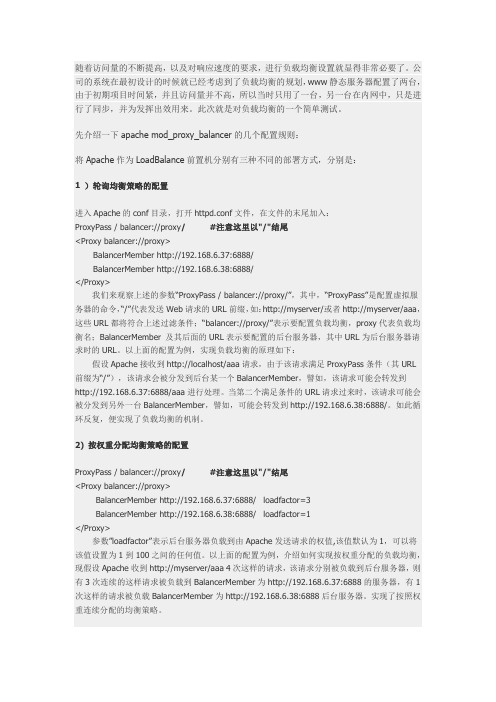
随着访问量的不断提高,以及对响应速度的要求,进行负载均衡设置就显得非常必要了。
公司的系统在最初设计的时候就已经考虑到了负载均衡的规划,www静态服务器配置了两台,由于初期项目时间紧,并且访问量并不高,所以当时只用了一台,另一台在内网中,只是进行了同步,并为发挥出效用来。
此次就是对负载均衡的一个简单测试。
先介绍一下apache mod_proxy_balancer的几个配置规则:将Apache作为LoadBalance前置机分别有三种不同的部署方式,分别是:1 )轮询均衡策略的配置进入Apache的conf目录,打开httpd.conf文件,在文件的末尾加入:ProxyPass / balancer://proxy/ #注意这里以"/"结尾<Proxy balancer://proxy>BalancerMember http://192.168.6.37:6888/BalancerMember http://192.168.6.38:6888/</Proxy>我们来观察上述的参数“ProxyPass / balancer://proxy/”,其中,“ProxyPass”是配置虚拟服务器的命令,“/”代表发送Web请求的URL前缀,如:http://myserver/或者http://myserver/aaa,这些URL都将符合上述过滤条件;“balancer://proxy/”表示要配置负载均衡,proxy代表负载均衡名;BalancerMember 及其后面的URL表示要配置的后台服务器,其中URL为后台服务器请求时的URL。
以上面的配置为例,实现负载均衡的原理如下:假设Apache接收到http://localhost/aaa请求,由于该请求满足ProxyPass条件(其URL 前缀为“/”),该请求会被分发到后台某一个BalancerMember,譬如,该请求可能会转发到http://192.168.6.37:6888/aaa进行处理。
Windows下Apache配置反向代理说明书V1.0

Allow from all
</Proxy>
ProxyPass /yourgateway http://127.0.0.1:8080/yourWebName
ProxyPassReverse /yourgateway http://127.0.0.1:8080/yourWebName
Apache配置反向代理说明书
序号
Байду номын сангаас步骤
1
安装ApacheHTTP服务器
使用文件:httpd-2.2.25-win32-x86-no_ssl.msi
安装成功完成后,屏幕右下角状态栏应该出现 图标,表示Apache服务已经开始运行
2
测试安装是否成功
打开浏览器,输入地址http://localhost/
预期页面
在此文件最后添加如下内容
Alias /yourwebapp"E:/yourworkspace/app"
<Directory "E:/yourworkspace/app">
Options Indexes FollowSymlinks
AllowOverride None
Order allow,deny
Allow from all
4
修改Apache Software Foundation\Apache2.2\conf\httpd.conf文件
在此文件最后添加如下内容(其127.0.0.1也可用localhost代替)
<IfModule mod_proxy.c>
ProxyRequests off
<Proxy /gateway>
nginx配置文件说明

Apache服务器和nginx的优缺点:我们之前大量使用Apache来作为HTTPServer。
Apache具有很优秀的性能,而且通过模块可以提供各种丰富的功能。
1)首先Apache对客户端的响应是支持并发的,运行httpd这个daemon进程之后,它会同时产生多个孩子进程/线程,每个孩子进程/线程分别对客户端的请求进行响应;2)另外,Apache可以提供静态和动态的服务,例如对于PHP的解析不是通过性能较差的CGI实现的而是通过支持PHP的模块来实现的(通常为mod_php5,或者叫做apxs2)。
3)缺点:因此通常称为Apache的这种Server为process-based server ,也就是基于多进程的HTTPServer,因为它需要对每个用户请求创建一个孩子进程/线程进行响应;这样的缺点是,如果并发的请求非常多(这在大型门户网站是很常见的)就会需要非常多的线程,从而占用极多的系统资源CPU和内存。
因此对于并发处理不是Apache的强项。
4)解决方法:目前来说出现了另一种WebServer,在并发方面表现更加优越,叫做asynchronous servers异步服务器。
最有名的为Nginx和Lighttpd。
所谓的异步服务器是事件驱动程序模式的event-driven,除了用户的并发请求通常只需要一个单一的或者几个线程。
因此占用系统资源就非常少。
这几种又被称为lightweight web server。
举例,对于10,000的并发连接请求,nginx可能仅仅使用几M的内存;而Apache 可能需要使用几百M的内存资源。
2. 实际中单一的使用:1)关于单一使用Apache来作为HTTPServer的情况我们不用再多做介绍,非常常见的应用;上面我们介绍到Apache对于PHP等服务器端脚本的支持是通过自己的模块来实现的,而且性能优越。
2)我们同样可以单单使用nginx或者lighttpd来作为HTTPServer来使用。
apache+tomcat6负载均衡

1、负载均衡模式:mod_proxy2、apache版本:httpd-2.2.253、tomcat版本:apache-tomcat-6.0.37解压版4、修改apache配置:conf/httpd.conf去掉行前面的#以打开下面配置:LoadModule proxy_module modules/mod_proxy.soLoadModule proxy_ajp_module modules/mod_proxy_ajp.soLoadModule proxy_balancer_module modules/mod_proxy_balancer.soLoadModule proxy_connect_module modules/mod_proxy_connect.soLoadModule proxy_ftp_module modules/mod_proxy_ftp.soLoadModule proxy_http_module modules/mod_proxy_http.so文件最后加入下面内容:<VirtualHost *:80>ServerAdmin [email]xxxx@[/email]ServerName localhostServerAlias localhostProxyPass / balancer://mycluster/ stickysession=JSESSIONID nofailover=OffProxyPassReverse / balancer://mycluster/ErrorLog "logs/error.log"CustomLog "logs/access.log" common</VirtualHost>ProxyRequests Off<proxy balancer://mycluster>BalancerMember ajp://127.0.0.1:41 loadfactor=1 route=tomcat6_node1BalancerMember ajp://127.0.0.1:42 loadfactor=1 route=tomcat6_node2# status=+H为配置热备,当所有机器都over时,才会请求该机器#BalancerMember http://192.168.1.218:8009 status=+H#按照请求次数均衡(默认)#ProxySet lbmethod=byrequests#按照权重#ProxySet lbmethod=bytraffic#按负载量,也就是往负载少的派发新请求#ProxySet lbmethod=bybusynessProxySet lbmethod=bybusyness</proxy>说明:其中VirtualHost *:80代表笔者本机的http server端口。
Apache启用mod_proxy做正向代理、反向代理(详细版)
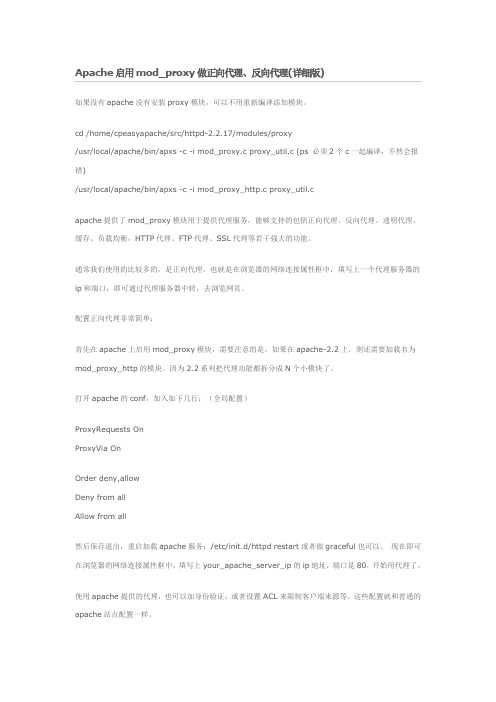
如果没有apache没有安装proxy模块,可以不用重新编译添加模块。
cd /home/cpeasyapache/src/httpd-2.2.17/modules/proxy/usr/local/apache/bin/apxs -c -i mod_proxy.c proxy_util.c (ps 必须2个c一起编译,不然会报错)/usr/local/apache/bin/apxs -c -i mod_proxy_http.c proxy_util.capache提供了mod_proxy模块用于提供代理服务,能够支持的包括正向代理、反向代理、透明代理、缓存、负载均衡,HTTP代理、FTP代理、SSL代理等若干强大的功能。
通常我们使用的比较多的,是正向代理。
也就是在浏览器的网络连接属性框中,填写上一个代理服务器的ip和端口,即可通过代理服务器中转,去浏览网页。
配置正向代理非常简单:首先在apache上启用mod_proxy模块,需要注意的是,如果在apache-2.2上,则还需要加载名为mod_proxy_http的模块。
因为2.2系列把代理功能都拆分成N个小模块了。
打开apache的conf,加入如下几行:(全局配置)ProxyRequests OnProxyVia OnOrder deny,allowDeny from allAllow from all然后保存退出,重启加载apache服务:/etc/init.d/httpd restart或者做graceful也可以。
现在即可在浏览器的网络连接属性框中,填写上your_apache_server_ip的ip地址,端口是80,开始用代理了。
使用apache提供的代理,也可以加身份验证,或者设置ACL来限制客户端来源等。
这些配置就和普通的apache站点配置一样。
配置反向代理就是个非常有用的功能。
例如从某地访问google太慢,但是机房服务器上很快,则可在服务器上设置反向代理连接到google,也就是把google映射到服务器上来访问。
apache_rewrite语法学习

RewriteBase /
对根目录进行重写
----------------------------------------------------------
5. RewriteRห้องสมุดไป่ตู้le 指令
说明
为重写引擎定义重写规则
语法
RewriteRule Pattern Substitution[flag]
NOTE:RewriteBase指令显示设置了目录级重写的基准,在下文中,你将看到RewriteRule
可以用于目录级的配置文件中(.htaccess)并在局部范围内起作用,即规则实际处理的只
是剥离了本地路径前缀的一部分。处理结束后,这个路径会被自动地附着回去。默认值"
RewriteBase physical-directory-path"。
兼容性
MaxRedirects在2.1及以后的版本种已经不可用
--------------------------------------------------------
3. RewriteLog 指令
说明
设置重写引擎日志的文件名
语法
RewriteOptions file_path
可以包括:
$N N表示序号,N=0~9,数字号与PATTERN想核匹配
%N引用最后一个RewriteCond模板中匹配的数据,N表示序号
%{VARNAME}服务器变量
${mapname:key|default}映射函数调用。当substitution有"-"前缀时,表示
不进行替换,只做匹配检查。
所指的资源永久消失了。
Apache负载均衡设置方法 mod_proxy

Apache负载均衡设置方法: mod_proxy 收藏Apache负载均衡设置方法: mod_proxy来源:网络收集一般来说,负载均衡就是将客户端的请求分流给后端的各个真实服务器,达到负载均衡的目的。
还有一种方式是用两台服务器,一台作为主服务器(Master),另一台作为热备份(Hot Standby),请求全部分给主服务器,在主服务器当机时,立即切换到备份服务器,以提高系统的整体可第一次看到这个标题时我也很惊讶,Apache居然还能做负载均衡?真是太强大了。
经过一番调查后发现的确可以,而且功能一点都不差。
这都归功于mod_proxy 这个模块。
不愧是强大的Apache啊。
废话少说,下面就来解释一下负载均衡的设置方法。
一般来说,负载均衡就是将客户端的请求分流给后端的各个真实服务器,达到负载均衡的目的。
还有一种方式是用两台服务器,一台作为主服务器(Master),另一台作为热备份(Hot Standby),请求全部分给主服务器,在主服务器当机时,立即切换到备份服务器,以提高系统的整体可靠性。
1. 负载均衡的设置1).基本配置Apache可以应对上面这两种需求。
先来讨论一下如何做负载均衡。
假设一台apache服务器域名为, 首先需要启用Apache的几个模块:Httpd.conf代码LoadModule proxy_module modules/mod_proxy.so LoadModule proxy_balancer_module modules/mod_proxy_balancer.soLoadModule proxy_http_module modules/mod_proxy_http.so LoadModule proxy_module modules/mod_proxy.so LoadModule proxy_balancer_module modules/mod_proxy_balancer.soLoadModule proxy_http_module modules/mod_proxy_http.somod_proxy提供代理服务器功能,mod_proxy_balancer提供负载均衡功能,mod_proxy_http让代理服务器能支持HTTP协议。
linux下安装apache的及反向代理配置完整过程

下面是linux下安装apache的完整代码,系统是redhat5.51、检查系统防火墙有没开,需要把防火墙关掉,可以执行SETUP查看,关闭。
在开启了防火墙时,做如下设置,开启相关端口,修改/etc/sysconfig/iptables 文件,添加以下内容:-A RH-Firewall-1-INPUT -m state --state NEW -m tcp -p tcp --dport 80 -j ACCEPT -A RH-Firewall-1-INPUT -m state --state NEW -m tcp -p tcp --dport 8088 -j ACCEPT 2、安装Apache下载地址:</>1. 安装Apache# tar zxvf httpd-2.2.22.tar.gz //解压文件# cd httpd-2.2.22//进入安装文件夹#./configure --prefix=/usr/local/apache --enable-so--enable-mods-shared=most --enable-proxy --enable-proxy-connect--enable-proxy-ftp --enable-proxy-http --enable-proxy-scgi--enable-proxy-ajp --enable-proxy-balancer // 配置apache路径加载动态模块# make //编译apache# make install//安装apache其它相关命令:下载httpd-2.2.22.tar.bz2 把httpd-2.2.22.tar.bz2放到/soft 下[root@localhost ~]#cd /soft[root@localhost soft]#tar jxvf httpd-2.2.6.tar.bz2 //解压apache的压缩包[root@localhost soft]#cd httpd-2.2.6 //定位到httpd-2.2.6 文件夹下[root@localhost httpd-2.2.6]#ls //查看显示httpd-2.2.6 文件夹下内容 [root@localhost httpd-2.2.6]# ./configure --help | more //查看安装apache配置参数[root@localhost httpd-2.2.6]#./configure --prefix=/usr/local/apache --enable-so // 配置apache路径[root@localhost httpd-2.2.6]#./configure --prefix=/usr/local/apache--enable-so --enable-mods-shared=most --enable-proxy--enable-proxy-connect --enable-proxy-ftp --enable-proxy-http--enable-proxy-scgi --enable-proxy-ajp --enable-proxy-balancer// 配置apache路径加载动态模块[root@localhost httpd-2.2.6]#make //编译apache[root@localhost httpd-2.2.6]#make install //安装apache[root@localhost httpd-2.2.6]#cd /usr/local/apache //进入apache的目录[root@localhost apache]# cd conf/[root@localhost conf]#cp httpd.conf httpd.conf_bak //备份apache配置文件[root@localhost conf]#chkconfig --list httpd //查看httpd服务是否已存在[root@localhost conf]#chkconfig httpd off //关闭系统自带了httpd的服务,如果存在httpd服务[root@localhost conf]#service httpd status //查看自带httpd服务状态[root@localhost conf]# /usr/local/apache/bin/apachectl -k start//linux启动apache命令[root@localhost conf]# /usr/local/apache/bin/apachectl -k stop //linux 停止apache命令[root@localhost conf]#netstat -an | grep :80 //查看linux80端口是否开启[root@localhost conf]#ps -aux | grep httpd //linux下查看apache进程[root@localhost conf]#cd ../..[root@localhost local]#cp /usr/local/apache/bin/apachectl/etc/rc.d/init.d/apache //拷贝apache启动脚本[root@localhost local]#vi /etc/rc.d/init.d/apache // 这里是编辑apache 启动脚本在开头的#!/bin/sh 下面加上#chkconfig: 2345 85 15[root@localhost local]#chkconfig --add apache //添加apache服务[root@localhost local]#chkconfig --list apache //列出apache服务[root@localhost local]#service apache stop //停止apache服务[root@localhost local]#netstat -an | grep :80 //查看linux的80端口是否开启[root@localhost local]#ps -aux | grep httpd //查看是否存在httpd服务,若果之前自带httpd服务启动的话会导致新添加的apache服务启动失败[root@localhost local]#service apache start //启动apache服务打开你的服务器ip地址,看看是否出现了tomcat的默认首页,如果出现的话,那么恭喜你linux下安装apache已经成功了3、修改httpd.conf文件vi /usr/local/apache/conf/httpd.conf以下为httpd.conf内容:# This is the main Apache HTTP server configuration file. It contains the # configuration directives that give the server its instructions.# See <URL:/docs/2.2> for detailed information.# In particular, see# <URL:/docs/2.2/mod/directives.html># for a discussion of each configuration directive.## Do NOT simply read the instructions in here without understanding# what they do. They're here only as hints or reminders. If you are unsure # consult the online docs. You have been warned.## Configuration and logfile names: If the filenames you specify for many # of the server's control files begin with "/" (or "drive:/" for Win32), the # server will use that explicit path. If the filenames do *not* begin # with "/", the value of ServerRoot is prepended -- so "logs/foo_log"# with ServerRoot set to "/usr/local/apache" will be interpreted by the # server as "/usr/local/apache/logs/foo_log".## ServerRoot: The top of the directory tree under which the server's# configuration, error, and log files are kept.## Do not add a slash at the end of the directory path. If you point# ServerRoot at a non-local disk, be sure to point the LockFile directive # at a local disk. If you wish to share the same ServerRoot for multiple # httpd daemons, you will need to change at least LockFile and PidFile. #ServerRoot "/usr/local/apache"## Listen: Allows you to bind Apache to specific IP addresses and/or# ports, instead of the default. See also the <VirtualHost># directive.## Change this to Listen on specific IP addresses as shown below to# prevent Apache from glomming onto all bound IP addresses.##Listen 12.34.56.78:80Listen 80Listen 8088 --增加监听端口## Dynamic Shared Object (DSO) Support## To be able to use the functionality of a module which was built as a DSO you# have to place corresponding `LoadModule' lines at this location so the # directives contained in it are actually available _before_ they are used.# Statically compiled modules (those listed by `httpd -l') do not need# to be loaded here.## Example:# LoadModule foo_module modules/mod_foo.so#LoadModule authn_file_module modules/mod_authn_file.so --加载的模块,正确安装完会自动加载以下模块LoadModule authn_dbm_module modules/mod_authn_dbm.soLoadModule authn_anon_module modules/mod_authn_anon.soLoadModule authn_dbd_module modules/mod_authn_dbd.soLoadModule authn_default_module modules/mod_authn_default.soLoadModule authz_host_module modules/mod_authz_host.soLoadModule authz_groupfile_module modules/mod_authz_groupfile.so LoadModule authz_user_module modules/mod_authz_user.soLoadModule authz_dbm_module modules/mod_authz_dbm.soLoadModule authz_owner_module modules/mod_authz_owner.soLoadModule authz_default_module modules/mod_authz_default.soLoadModule auth_basic_module modules/mod_auth_basic.soLoadModule auth_digest_module modules/mod_auth_digest.soLoadModule dbd_module modules/mod_dbd.soLoadModule dumpio_module modules/mod_dumpio.soLoadModule reqtimeout_module modules/mod_reqtimeout.soLoadModule ext_filter_module modules/mod_ext_filter.soLoadModule include_module modules/mod_include.soLoadModule filter_module modules/mod_filter.soLoadModule substitute_module modules/mod_substitute.soLoadModule deflate_module modules/mod_deflate.soLoadModule log_config_module modules/mod_log_config.soLoadModule logio_module modules/mod_logio.soLoadModule env_module modules/mod_env.soLoadModule expires_module modules/mod_expires.soLoadModule headers_module modules/mod_headers.soLoadModule ident_module modules/mod_ident.soLoadModule setenvif_module modules/mod_setenvif.soLoadModule version_module modules/mod_version.soLoadModule proxy_module modules/mod_proxy.soLoadModule proxy_connect_module modules/mod_proxy_connect.soLoadModule proxy_ftp_module modules/mod_proxy_ftp.soLoadModule proxy_http_module modules/mod_proxy_http.soLoadModule proxy_scgi_module modules/mod_proxy_scgi.soLoadModule proxy_ajp_module modules/mod_proxy_ajp.soLoadModule proxy_balancer_module modules/mod_proxy_balancer.so LoadModule mime_module modules/mod_mime.soLoadModule dav_module modules/mod_dav.soLoadModule status_module modules/mod_status.soLoadModule autoindex_module modules/mod_autoindex.soLoadModule asis_module modules/mod_asis.soLoadModule info_module modules/mod_info.soLoadModule cgi_module modules/mod_cgi.soLoadModule dav_fs_module modules/mod_dav_fs.soLoadModule vhost_alias_module modules/mod_vhost_alias.soLoadModule negotiation_module modules/mod_negotiation.soLoadModule dir_module modules/mod_dir.soLoadModule imagemap_module modules/mod_imagemap.soLoadModule actions_module modules/mod_actions.soLoadModule speling_module modules/mod_speling.soLoadModule userdir_module modules/mod_userdir.soLoadModule alias_module modules/mod_alias.soLoadModule rewrite_module modules/mod_rewrite.soTimeout 300 --新增的配置参数KeepAlive OnMaxKeepAliveRequests 1000KeepAliveTimeout 15UseCanonicalName OffAccessFileName .htaccessServerTokens FullServerSignature OnHostnameLookups Off<IfModule !mpm_netware_module><IfModule !mpm_winnt_module>## If you wish httpd to run as a different user or group, you must run # httpd as root initially and it will switch.## User/Group: The name (or #number) of the user/group to run httpd as. # It is usually good practice to create a dedicated user and group for # running httpd, as with most system services.#User daemonGroup daemon</IfModule></IfModule>----------------------------------以下内容是新增的关键参数<IfModule mpm_prefork_module>StartServers 40MinSpareServers 40MaxSpareServers 80MaxClients 256MaxRequestsPerChild 10000</IfModule><IfModule mpm_worker_module>StartServers 40MaxClients 2000MinSpareThreads 100MaxSpareThreads 300ThreadsPerChild 200MaxRequestsPerChild 0</IfModule>ProxyRequests OffRewriteEngine onRewriteCond %{REQUEST_METHOD} ^(TRACE|TRACK)RewriteRule .* - [F]RewriteEngine onRewriteCond %{HTTP:range} !(^bytes=[^,]+(,[^,]+){0,4}$|^$)RewriteRule .* - [F]TraceEnable off#NameVirtualHost 10.46.85.137:9080#<VirtualHost 10.46.85.137:9080>#ServerName 10.46.85.137:9080#ProxyPass /ponApp/ http://10.209.122.40:7001/xponApp/#ProxyPassReverse /ponApp/ http://10.209.122.40:7001/xponApp/#</VirtualHost>NameVirtualHost 10.46.85.137:8088<VirtualHost 10.46.85.137:8088>ServerName kuangdai --kuangdai LINUX系统的主机名ProxyPass /xponApp/ http://10.209.122.40:7001/xponApp/ ProxyPassReverse /xponApp/ http://10.209.122.40:7001/xponApp/启动服务报错--/etc/hosts 增加127.0.0.1 localhost.localdomainlocalhost ”kuangdai“主机名</VirtualHost><Proxy *>--配置反向代理的访问权限Order deny,allowAllow from all</Proxy>-----------------------------以上内容是新增的关键参数# 'Main' server configuration## The directives in this section set up the values used by the 'main'# server, which responds to any requests that aren't handled by a# <VirtualHost> definition. These values also provide defaults for# any <VirtualHost> containers you may define later in the file.## All of these directives may appear inside <VirtualHost> containers,# in which case these default settings will be overridden for the# virtual host being defined.### ServerAdmin: Your address, where problems with the server should be# e-mailed. This address appears on some server-generated pages, such # as error documents. e.g. admin@#ServerAdmin you@## ServerName gives the name and port that the server uses to identify itself.# This can often be determined automatically, but we recommend you specify # it explicitly to prevent problems during startup.## If your host doesn't have a registered DNS name, enter its IP address here. #ServerName 127.0.0.1:80 --这个ServerName可随意配置一定去掉前面### DocumentRoot: The directory out of which you will serve your# documents. By default, all requests are taken from this directory, but # symbolic links and aliases may be used to point to other locations.#DocumentRoot "/usr/local/apache/htdocs"## Each directory to which Apache has access can be configured with respect # to which services and features are allowed and/or disabled in that# directory (and its subdirectories).## First, we configure the "default" to be a very restrictive set of# features.#<Directory />Options FollowSymLinksAllowOverride NoneOrder deny,allowDeny from all</Directory>## Note that from this point forward you must specifically allow# particular features to be enabled - so if something's not working as # you might expect, make sure that you have specifically enabled it# below.### This should be changed to whatever you set DocumentRoot to.#<Directory "/usr/local/apache/htdocs">## Possible values for the Options directive are "None", "All",# or any combination of:# Indexes Includes FollowSymLinks SymLinksifOwnerMatch ExecCGI MultiViews## Note that "MultiViews" must be named *explicitly* --- "Options All" # doesn't give it to you.## The Options directive is both complicated and important. Please see # /docs/2.2/mod/core.html#options# for more information.#Options Indexes FollowSymLinks## AllowOverride controls what directives may be placed in .htaccess files.# It can be "All", "None", or any combination of the keywords:# Options FileInfo AuthConfig Limit#AllowOverride None## Controls who can get stuff from this server.#Order allow,denyAllow from all</Directory>## DirectoryIndex: sets the file that Apache will serve if a directory# is requested.#<IfModule dir_module>DirectoryIndex index.html</IfModule>## The following lines prevent .htaccess and .htpasswd files from being # viewed by Web clients.#<FilesMatch "^\.ht">Order allow,denyDeny from allSatisfy All</FilesMatch>## ErrorLog: The location of the error log file.# If you do not specify an ErrorLog directive within a <VirtualHost># container, error messages relating to that virtual host will be# logged here. If you *do* define an error logfile for a <VirtualHost> # container, that host's errors will be logged there and not here.#ErrorLog "logs/error_log"## LogLevel: Control the number of messages logged to the error_log.# Possible values include: debug, info, notice, warn, error, crit,# alert, emerg.#LogLevel warn<IfModule log_config_module>## The following directives define some format nicknames for use with # a CustomLog directive (see below).#LogFormat "%h %l %u %t \"%r\" %>s %b \"%{Referer}i\" \"%{User-Agent}i\"" combinedLogFormat "%h %l %u %t \"%r\" %>s %b" common<IfModule logio_module># You need to enable mod_logio.c to use %I and %OLogFormat "%h %l %u %t \"%r\" %>s %b \"%{Referer}i\"\"%{User-Agent}i\" %I %O" combinedio</IfModule>## The location and format of the access logfile (Common Logfile Format). # If you do not define any access logfiles within a <VirtualHost># container, they will be logged here. Contrariwise, if you *do*# define per-<VirtualHost> access logfiles, transactions will be# logged therein and *not* in this file.#CustomLog "logs/access_log" common## If you prefer a logfile with access, agent, and referer information # (Combined Logfile Format) you can use the following directive.##CustomLog "logs/access_log" combined</IfModule><IfModule alias_module>## Redirect: Allows you to tell clients about documents that used to # exist in your server's namespace, but do not anymore. The client # will make a new request for the document at its new location.# Example:# Redirect permanent /foo /bar## Alias: Maps web paths into filesystem paths and is used to# access content that does not live under the DocumentRoot.# Example:# Alias /webpath /full/filesystem/path## If you include a trailing / on /webpath then the server will# require it to be present in the URL. You will also likely# need to provide a <Directory> section to allow access to# the filesystem path.## ScriptAlias: This controls which directories contain server scripts. # ScriptAliases are essentially the same as Aliases, except that# documents in the target directory are treated as applications and # run by the server when requested rather than as documents sent to the # client. The same rules about trailing "/" apply to ScriptAlias# directives as to Alias.#ScriptAlias /cgi-bin/ "/usr/local/apache/cgi-bin/"</IfModule><IfModule cgid_module>## ScriptSock: On threaded servers, designate the path to the UNIX# socket used to communicate with the CGI daemon of mod_cgid.##Scriptsock logs/cgisock</IfModule>## "/usr/local/apache/cgi-bin" should be changed to whatever your ScriptAliased# CGI directory exists, if you have that configured.#<Directory "/usr/local/apache/cgi-bin">AllowOverride NoneOptions NoneOrder allow,denyAllow from all</Directory>## DefaultType: the default MIME type the server will use for a document # if it cannot otherwise determine one, such as from filename extensions. # If your server contains mostly text or HTML documents, "text/plain" is # a good value. If most of your content is binary, such as applications # or images, you may want to use "application/octet-stream" instead to # keep browsers from trying to display binary files as though they are # text.#DefaultType text/plain<IfModule mime_module>## TypesConfig points to the file containing the list of mappings from # filename extension to MIME-type.#TypesConfig conf/mime.types## AddType allows you to add to or override the MIME configuration# file specified in TypesConfig for specific file types.##AddType application/x-gzip .tgz## AddEncoding allows you to have certain browsers uncompress# information on the fly. Note: Not all browsers support this.##AddEncoding x-compress .Z#AddEncoding x-gzip .gz .tgz## If the AddEncoding directives above are commented-out, then you# probably should define those extensions to indicate media types: #AddType application/x-compress .ZAddType application/x-gzip .gz .tgz## AddHandler allows you to map certain file extensions to "handlers": # actions unrelated to filetype. These can be either built into the server # or added with the Action directive (see below)## To use CGI scripts outside of ScriptAliased directories:# (You will also need to add "ExecCGI" to the "Options" directive.) ##AddHandler cgi-script .cgi# For type maps (negotiated resources):#AddHandler type-map var## Filters allow you to process content before it is sent to the client. ## To parse .shtml files for server-side includes (SSI):# (You will also need to add "Includes" to the "Options" directive.) ##AddType text/html .shtml#AddOutputFilter INCLUDES .shtml</IfModule>## The mod_mime_magic module allows the server to use various hints from the # contents of the file itself to determine its type. The MIMEMagicFile # directive tells the module where the hint definitions are located.##MIMEMagicFile conf/magic## Customizable error responses come in three flavors:# 1) plain text 2) local redirects 3) external redirects## Some examples:#ErrorDocument 500 "The server made a boo boo."#ErrorDocument 404 /missing.html#ErrorDocument 404 "/cgi-bin/missing_handler.pl"#ErrorDocument 402 /subscription_info.html### MaxRanges: Maximum number of Ranges in a request before# returning the entire resource, or one of the special# values 'default', 'none' or 'unlimited'.# Default setting is to accept 200 Ranges.#MaxRanges unlimited## EnableMMAP and EnableSendfile: On systems that support it,# memory-mapping or the sendfile syscall is used to deliver# files. This usually improves server performance, but must# be turned off when serving from networked-mounted# filesystems or if support for these functions is otherwise# broken on your system.##EnableMMAP off#EnableSendfile off# Supplemental configuration## The configuration files in the conf/extra/ directory can be# included to add extra features or to modify the default configuration of # the server, or you may simply copy their contents here and change as# necessary.# Server-pool management (MPM specific)#Include conf/extra/httpd-mpm.conf# Multi-language error messages#Include conf/extra/httpd-multilang-errordoc.conf# Fancy directory listings#Include conf/extra/httpd-autoindex.conf# Language settings#Include conf/extra/httpd-languages.conf# User home directories#Include conf/extra/httpd-userdir.conf# Real-time info on requests and configuration#Include conf/extra/httpd-info.conf# Virtual hosts#Include conf/extra/httpd-vhosts.conf# Local access to the Apache HTTP Server Manual#Include conf/extra/httpd-manual.conf# Distributed authoring and versioning (WebDAV)#Include conf/extra/httpd-dav.conf# Various default settings#Include conf/extra/httpd-default.conf# Secure (SSL/TLS) connections#Include conf/extra/httpd-ssl.conf## Note: The following must must be present to support# starting without SSL on platforms with no /dev/random equivalent # but a statically compiled-in mod_ssl.#<IfModule ssl_module>SSLRandomSeed startup builtinSSLRandomSeed connect builtin </IfModule>。
apache proxypass用法
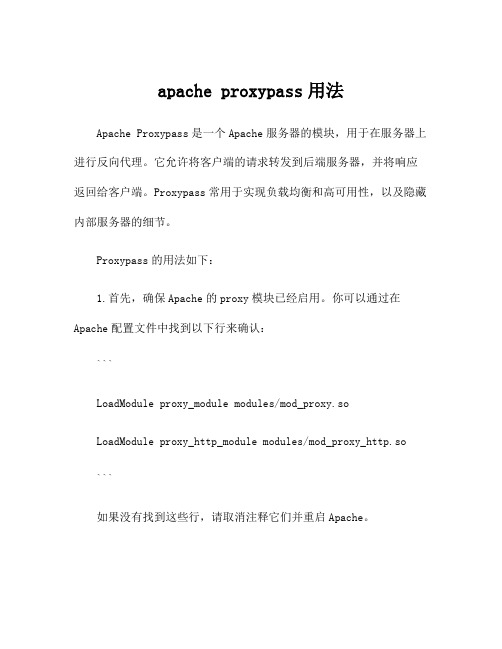
apache proxypass用法Apache Proxypass是一个Apache服务器的模块,用于在服务器上进行反向代理。
它允许将客户端的请求转发到后端服务器,并将响应返回给客户端。
Proxypass常用于实现负载均衡和高可用性,以及隐藏内部服务器的细节。
Proxypass的用法如下:1.首先,确保Apache的proxy模块已经启用。
你可以通过在Apache配置文件中找到以下行来确认:```LoadModule proxy_module modules/mod_proxy.soLoadModule proxy_http_module modules/mod_proxy_http.so```如果没有找到这些行,请取消注释它们并重启Apache。
2.在Apache配置文件中,添加一个ProxyPass指令来配置反向代理。
该指令通常具有以下语法:```ProxyPass /path http://backend-server-ip:port```其中,/path是客户端请求的URI的前缀,http://backend-server-ip:port是要转发到的后端服务器的地址。
你还可以使用ProxyPassMatch指令来进行更高级的请求匹配,例如使用正则表达式匹配某些特定的路径。
3.配置好ProxyPass后,重新启动Apache服务器以使配置生效。
除了基本的ProxyPass指令,还可以使用其他参数和选项来进行更高级的配置:- ProxyPassReverse:用于修改响应头中的Location和链接地址,确保返回给客户端的链接指向正确的地址。
- ProxyPassReverseCookieDomain和ProxyPassReverseCookiePath:用于修改Cookie中的域名和路径,确保Cookie在跨域访问时正常工作。
- ProxyPassReverseCookiePath:用于修改响应体中的链接地址,确保返回给客户端的页面中的链接指向正确的地址。
location的proxypass匹配规则-概述说明以及解释

location的proxypass匹配规则-概述说明以及解释1. 引言1.1 概述在网络领域中,代理服务器是一种常见的网络架构模式,它充当客户端和目标服务器之间的中间人。
当客户端发送请求时,代理服务器将该请求转发到目标服务器,并将响应返回给客户端。
为了实现代理服务器的功能,Apache服务器提供了一个重要的模块——mod_proxy。
而在mod_proxy模块中,我们可以使用`ProxyPass` 指令来配置代理规则。
当需要配置代理服务器时,我们常常会使用Apache服务器的`location`指令来定义URL的匹配规则。
`location`指令允许用户根据URL 的特征来执行不同的操作,比如代理转发。
通过使用`location`指令,我们可以通过匹配URL中的特定片段来决定是否将请求转发到代理服务器。
然而,在实际应用中,我们可能会遇到多个代理规则同时存在的情况。
为了确定请求应该被哪个规则匹配到,Apache服务器提供了`ProxyPassMatch`指令。
与`ProxyPass`指令不同,`ProxyPassMatch`允许我们使用正则表达式来匹配URL。
通过使用`ProxyPassMatch`指令,我们可以更加灵活地配置代理规则,提供更加精确的匹配。
本文将深入探讨`location`的`ProxyPass`和`ProxyPassMatch`匹配规则,重点介绍它们的使用方法和注意事项。
我们将会从基础概念开始讲解,逐渐深入到实际应用场景和一些常见问题的解决方案。
通过阅读本文,读者将能够全面掌握`location`的`ProxyPass`和`ProxyPassMatch`功能,且能够根据实际需求合理配置代理规则,提升代理服务器的性能和安全性。
接下来,本文将按照以下结构进行阐述。
在第二部分,我们将详细介绍`ProxyPass`指令的使用方法和常用配置示例。
第三部分将深入讨论`ProxyPassMatch`指令,并提供一些实际应用场景的案例。
nginxlocation中多个if里面proxy_pass的方法
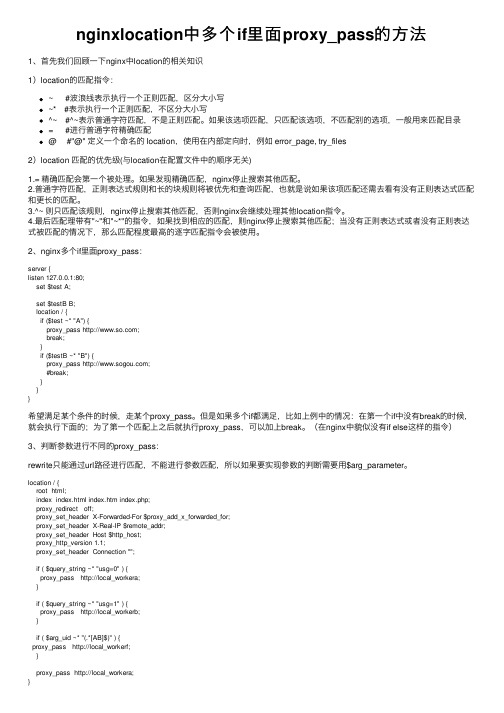
nginxlocation中多个if⾥⾯proxy_pass的⽅法1、⾸先我们回顾⼀下nginx中location的相关知识1)location的匹配指令:~ #波浪线表⽰执⾏⼀个正则匹配,区分⼤⼩写~* #表⽰执⾏⼀个正则匹配,不区分⼤⼩写^~ #^~表⽰普通字符匹配,不是正则匹配。
如果该选项匹配,只匹配该选项,不匹配别的选项,⼀般⽤来匹配⽬录= #进⾏普通字符精确匹配@ #"@" 定义⼀个命名的 location,使⽤在内部定向时,例如 error_page, try_files2)location 匹配的优先级(与location在配置⽂件中的顺序⽆关)1.= 精确匹配会第⼀个被处理。
如果发现精确匹配,nginx停⽌搜索其他匹配。
2.普通字符匹配,正则表达式规则和长的块规则将被优先和查询匹配,也就是说如果该项匹配还需去看有没有正则表达式匹配和更长的匹配。
3.^~ 则只匹配该规则,nginx停⽌搜索其他匹配,否则nginx会继续处理其他location指令。
4.最后匹配理带有"~"和"~*"的指令,如果找到相应的匹配,则nginx停⽌搜索其他匹配;当没有正则表达式或者没有正则表达式被匹配的情况下,那么匹配程度最⾼的逐字匹配指令会被使⽤。
2、nginx多个if⾥⾯proxy_pass:server {listen 127.0.0.1:80;set $test A;set $testB B;location / {if ($test ~* "A") {proxy_pass ;break;}if ($testB ~* "B") {proxy_pass ;#break;}}}希望满⾜某个条件的时候,⾛某个proxy_pass。
但是如果多个if都满⾜,⽐如上例中的情况:在第⼀个if中没有break的时候,就会执⾏下⾯的;为了第⼀个匹配上之后就执⾏proxy_pass,可以加上break。
让apache反向代理iis及多域名设置

AllowOverride None
Order Deny,Allow
Allow from all
</Directory>
</VirtualHost>
四、asp页面访问,apache反向代理iis,以及rewrite综合设置。
要在apache中访问asp,则需要用到proxypass,即在第二步中先打开的代理模块。
一、首先安装好apache及iis,设置apache端口80,iis端口81(这里只要别和apache冲突就行了)
二、找到apache的配置文件httpd.conf,去掉下面语句的注释
LoadModule proxy_module modules/mod_proxy.so
LoadModule proxy_connect_module modules/mod_proxy_connect.so
proxyreverse /test http://123.0.0.1:81/test
# 请使用相同目录名,否则路径会出错,就是通过在浏览器中输入a.b.c,会访问“d:\www\abc\”根目录下文件;若输入a.b.c/test,就会通过apache的反向代理访问至iis下的test目录(或test虚拟目录),以此类推,可以相应多设置需要执行asp的目录。
RewriteCond %{REQUEST_URI} ^/.*(\.asp)x?\??.*$ [NC]
RewriteRule ^/test/(.*) http://123.0.0.1:808/test/$1 [P]
#把html文件的请求转到iis处理
RewriteCond %{REQUEST_URI} ^/.*(\.html)?\??.*$ [NC]
SVN主从服务(APACHE-PROXY模式)设置说明
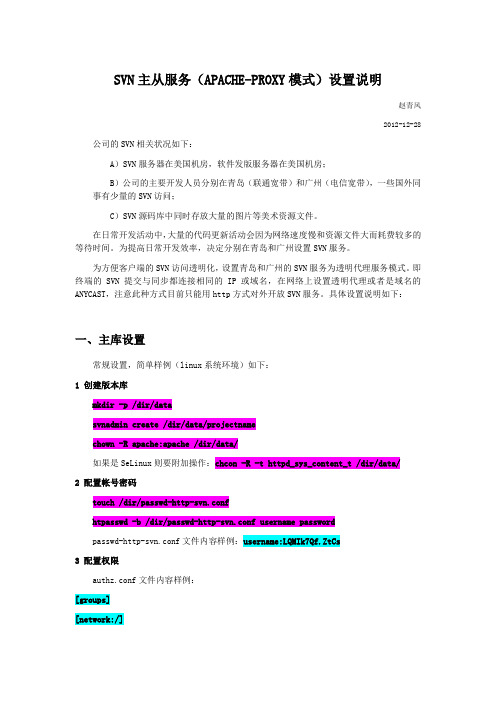
SVN主从服务(APACHE-PROXY模式)设置说明赵青风2012-12-28 公司的SVN相关状况如下:A)SVN服务器在美国机房,软件发版服务器在美国机房;B)公司的主要开发人员分别在青岛(联通宽带)和广州(电信宽带),一些国外同事有少量的SVN访问;C)SVN源码库中同时存放大量的图片等美术资源文件。
在日常开发活动中,大量的代码更新活动会因为网络速度慢和资源文件大而耗费较多的等待时间。
为提高日常开发效率,决定分别在青岛和广州设置SVN服务。
为方便客户端的SVN访问透明化,设置青岛和广州的SVN服务为透明代理服务模式。
即终端的SVN提交与同步都连接相同的IP或域名,在网络上设置透明代理或者是域名的ANYCAST,注意此种方式目前只能用http方式对外开放SVN服务。
具体设置说明如下:一、主库设置常规设置,简单样例(linux系统环境)如下:1 创建版本库mkdir -p/dir/datasvnadmin create /dir/data/projectnamechown -R apache:apache /dir/data/如果是SeLinux则要附加操作:chcon -R -t httpd_sys_content_t/dir/data/2 配置帐号密码touch /dir/passwd-http-svn.confhtpasswd -b /dir/passwd-http-svn.conf username passwordpasswd-http-svn.conf文件内容样例:username:LQMIk7Qf.ZtCs3 配置权限authz.conf文件内容样例:[groups][network:/]username=rw4 apache服务配置文件httpd.conf文件增加SVN相关内容:LoadModule dav_svn_module modules/mod_dav_svn.soLoadModule authz_svn_module modules/mod_authz_svn.soInclude conf/extra/httpd-svn.confhttpd-svn.conf文件内容样例:<Location /svn>DAV svnSVNListParentPath OnSVNParentPath /dir/dataAuthType BasicAuthName "Subversion Repository"AuthUserFile /dir/passwd-httpd.confAuthzSVNAccessFile /dir/authz.confRequire valid-user</Location>5 开启服务apachectl start此时访问SVN版本库的路径为:http://masterip:masterport/svn/projectname 二、从库设置应当保证操作系统、服务软件等版本与主服务器完全一致,具体步骤与主库相同。
proxy_redirect 用法

proxy_redirect 指令用于在Nginx 中配置反向代理服务器对客户端重定向响应的处理。
它可以更改重定向响应中的URL,以便将它们指向反向代理服务器而不是原始服务器。
语法:
proxy_redirect [ off | default | redirect replacement ]
off: 不处理重定向响应
default: 使用默认设置,即仅保留重定向URL中的主机部分
redirect replacement: 使用指定的重定向URL替换原始URL
例如:
location / {
proxy_pass http://backend;
proxy_redirect http://backend/ http://$host/;
}
上面的例子中,当反向代理服务器返回一个重定向响应,其中URL是"http://backend/path" ,Nginx将其替换为"http://$host/path" 并发送给客户端。
请注意,如果您使用proxy_redirect 指令更改重定向响应中的URL,则需要确保该URL是可访问的,否则客户端将无法重定向到正确的位置。
location proxy_pass 丢失参数
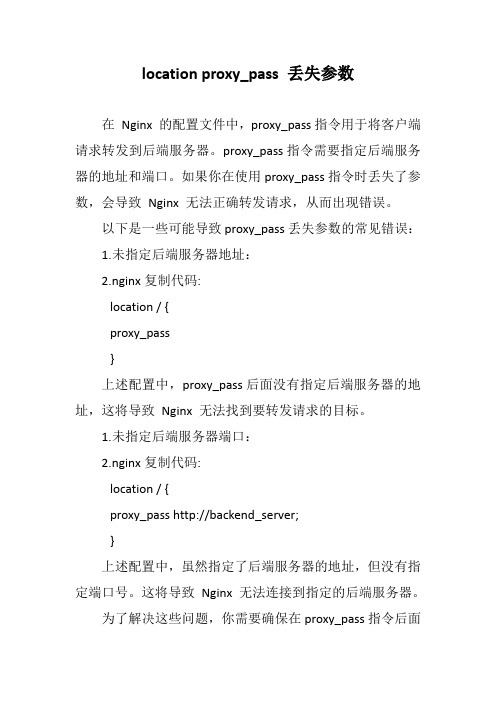
location proxy_pass 丢失参数
在Nginx 的配置文件中,proxy_pass 指令用于将客户端请求转发到后端服务器。
proxy_pass 指令需要指定后端服务器的地址和端口。
如果你在使用 proxy_pass 指令时丢失了参数,会导致Nginx 无法正确转发请求,从而出现错误。
以下是一些可能导致 proxy_pass 丢失参数的常见错误:
1.未指定后端服务器地址:
2.nginx复制代码:
location / {
proxy_pass
}
上述配置中,proxy_pass 后面没有指定后端服务器的地址,这将导致Nginx 无法找到要转发请求的目标。
1.未指定后端服务器端口:
2.nginx复制代码:
location / {
proxy_pass http://backend_server;
}
上述配置中,虽然指定了后端服务器的地址,但没有指定端口号。
这将导致Nginx 无法连接到指定的后端服务器。
为了解决这些问题,你需要确保在 proxy_pass 指令后面
提供完整的后端服务器地址和端口。
例如:
nginx复制代码:
location / {
proxy_pass http://backend_server:8080;
}
上述配置中,http://backend_server:8080 是后端服务器的完整地址和端口号。
这样,Nginx 将正确转发请求到指定的后端服务器。
请检查你的Nginx 配置文件,确保 proxy_pass 指令后面有完整的参数,以避免请求转发失败的问题。
- 1、下载文档前请自行甄别文档内容的完整性,平台不提供额外的编辑、内容补充、找答案等附加服务。
- 2、"仅部分预览"的文档,不可在线预览部分如存在完整性等问题,可反馈申请退款(可完整预览的文档不适用该条件!)。
- 3、如文档侵犯您的权益,请联系客服反馈,我们会尽快为您处理(人工客服工作时间:9:00-18:30)。
描述:将远程服务器映射到本地服务器的URL空间语法:ProxyPass [路径] !|url [键=值键=值...]] [nocanon]上下文:server config, virtual host, directory状态:扩展模块:mod_proxy该指令可以将远程服务器映射到本地服务器的URL空间;本地的服务器并不是扮演传统意义上的代理服务器的角色,而是表现为远程服务器的一个镜像。
此本地服务器常被成为反向代理(reversed proxy)或者是网关(gateway)。
路径是指本地虚拟路径的名字;url指远程服务器的一个部分URL,不能包含查询字符串。
注意:在使用ProxyPass指令的时候,ProxyRequests指令通常都应该是关闭的。
假设本地服务器的地址是/ ,那么ProxyPass /mirror/foo/ /将会把对/mirror/foo/bar的本地请求内部转换成到/bar的代理请求。
其中,!指令当你不想对某个子目录进行反向代理的时候就有用了,例如:ProxyPass /mirror/foo/i !ProxyPass /mirror/foo 将会把所有的/mirror/foo请求重定向到除了对/mirror/foo/i的请求。
注意:顺序很重要:排除的指令必须在一般的ProxyPass指令之前。
和Apache 2.1一样,具备了使用到后端服务器的线程池的能力。
使用“键=值”的参数便可调节线程池的分配。
硬性最大值(Hard Maximum)的默认值为当前MPM中每个进程的线程数量。
在Prefork MPM中,该值总是为1,在Worker MPM中,该值受ThreadsPerChild控制。
设置min可以决定有多少到后端服务器的链接始终打开。
根据需要最多创建数量为柔性最大值(Soft Maximum),也就是smax的链接。
任何超出smax数量的链接都会指定一个生存时间也就是ttl。
Apache不会同时创建超过硬性最大值(或max)数量的到后端服务器的链接。
ProxyPass /example smax=5 max=20 ttl=120 retry=300参数默认值描述min 0 到后端服务器的总是打开的链接最小数。
max 1…n 允许连接到后端服务器的硬性最大链接数。
硬性最大值的默认值为当前MPM 中每个进程的线程数量。
在Prefork MPM中,该值总是为1,在Worker MPM中,该值受ThreadsPerChild控制。
smax max 根据需要最多创建数量为柔性最大值(Soft Maximum),也就是smax的链接。
任何超出smax数量的链接都会指定一个生存时间也就是ttl。
acquire - 如果设置了该参数,它就会成为等待链接池中空闲链接的最大时间。
如果链接池中没有任何空闲链接,那么Apache将会给客户端返回SERVER_BUSY状态。
flushpackets off 决定代理模块是否要在接受到每段数据的时候自动冲掉输出缓冲。
‘off’表示只有当需要的时候才冲掉,‘on’表示每段数据后都冲,‘auto’表示轮询/等待一段长度为‘flushwait’毫秒的时间后如果没有输入便冲掉。
目前该参数仅对AJP有效。
flushwait 10 表示如果‘flushpackets’为‘auto’,在冲掉输出组前等待额外输入的时间,单位毫秒。
keepalive Off 该参数应该在你的Apache和后端服务器之间有防火墙的时候时候,因为防火墙有可能会丢弃不活动的链接。
该标志将会告诉操作系统在不活动的链接中发送KEEP_ALIVE 消息(时间间隔由全局的OS设置决定,一般为120ms),这样避免防火墙丢弃该链接。
要启用keepalive可以将该属性设置为On。
lbset 0对该工作单元所属的负载均衡集群进行设置。
负载均衡器会先尝试较小的lbset,然后尝试大的。
ping 0 Ping数据告诉Web服务器在对ajp13链接递交请求前发送一个CPING请求。
参数为等待CPONG响应的延迟,单位为秒。
添加该功能是为了避免挂起和忙碌的Tomcat的一些问题。
该功能需要ajp13 的ping/pong支持,已经在Tomcat 3.3.2+、4.1.28+、5.0.13+中实现。
它会增加普通操作中的网络流量,有可能是个问题,但是它在集群节点失效或者繁忙的时候减少网络流量。
目前该参数只对AJP有效。
loadfactor 1 工作单元负载系数。
用于BalancerMember。
它是一个1到100之间的数字,用于定义应用于该工作单元的正规化权重负载。
redirect - 工作单元的重定向路由(Redirection Route)。
该值通常被动态设置用于从集群中安全地移除某个节点。
如果被设置了,所有不包含会话ID的请求都会被重定向到有等值route参数的BalancerMember中。
retry 60 线程池工作单元重试的超时时间,以秒为单位。
如果到后端服务器的线程池工作单元状态是出错,Apache将不会递交任何请求到该服务器,直到超时结束。
这可以令后端服务器关闭进行维护,并稍后上线。
如果值为0则表示总是重试错误状态的工作单元不等待任何时间。
route - 工作单元的路由,用于负载均衡器中。
该路由是附加给会话ID的一个值。
status - 用一个字符定义该工作单元的初始状态:‘D’表示禁用,‘S’表示已停止,‘I’表示忽略错误,‘H’表示热备,‘E’表示出错。
状态可以通过前置‘+’表示设置或者‘-’表示清楚。
这样,‘S-E’表示设置该工作单元为已停止并清除出错标志。
timeout Timeout 链接超时时间,单位为秒。
如果未设置,那么Apache会一直等到有可用的链接位置。
该指令常和max参数一起使用来限制到后端服务器的链接。
ttl - 超出smax连接数的非活动链接的生存时间(Time To Live),单位为秒。
Apache会关闭在这段时间内没有被用过的所有链接。
如果代理的指令类型以balancer://开头那么会创建一个虚拟工作单元,并不直接和后端服务器通讯。
它负责对一些“真正”的工作单元进行管理。
这种情况下可以给虚拟工作单元添加一系列额外参数。
更多关于均衡器如何工作的信息请查看mod_proxy_balancer。
参数默认值描述lbmethod b yrequests 选择均衡器的负载均衡方式。
可以是byrequests,进行加权请求计数,或者是bytraffic,进行加权流量字节计数均衡。
默认按请求数。
maxattempts 1 在放弃之前的故障转移的最大尝试次数。
nofailover Off 如果设为‘On’,当工作单元被禁用或者出错时,会话则立即中断。
可以将该值设为On如果后端服务器不支持会话复制(Session replication)。
stickysession - 均衡器粘连会话名称。
该值常常会被设置为类似JSESSIONID或者PHPSESSIONID之类的值,他依赖于支持会话的后端应用服务器。
如果后端服务器使用不同的cookie名称或者URL编码的ID(像servlet容器),使用|来分开他们。
第一个部分针对cookie,第二个针对路径。
timeout 0 均衡器超时时间,单位为秒。
如果设置了,那么就是等待空闲工作单元的最大时间。
默认是不等。
均衡器设置范例ProxyPass /special-area / smax=5 max=10ProxyPass / balancer://mycluster stickysession=JSESSIONID|jsessionid nofailover=On<Proxy balancer://mycluster>BalancerMember http://1.2.3.4:8009BalancerMember http://1.2.3.5:8009 smax=10# 性能较弱的服务器,不要给他发送太多请求BalancerMember http://1.2.3.6:8009 smax=1 loadfactor=20</Proxy>设置一个热备份,也就是只有当没有其他成员可用的时候才使用:ProxyPass / balancer://hotcluster/<Proxy balancer://hotcluster>BalancerMember http://1.2.3.4:8009 loadfactor=1BalancerMember http://1.2.3.5:8009 loadfactor=2# 以下是热备份BalancerMember http://1.2.3.6:8009 status=+HProxySet lbmethod=bytraffic </Proxy>正常情况下,mod_proxy会标准化被ProxyPass的URL。
但它可能会和某些后端不兼容,尤其是那些利用了PATH_INFO的。
可选的nocanon关键词可以禁止它,并不动地直接将URL 路径传递给后端。
注意它可能会影响到后端的安全性,因为它跳过了由代理提供的对常见的基于URL的攻击的保护。
当用在<Location>节中的时候,第一个参数应被忽略,并且本地的路径将从<Location>取得。
如果你需要更加有弹性的反向代理配置,参见是用[P]标志的RewriteRule指令。
